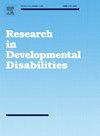Association between physical activity levels and physical fitness in people with intellectual disabilities: Controlling for sex, age, and disability level
IF 2.6
2区 医学
Q1 EDUCATION, SPECIAL
引用次数: 0
Abstract
Background
To evaluate associations between physical activity levels and specific components of physical fitness in adults with intellectual disabilities (ID).
Method
Sixty-two adults with mild to moderate ID (29 females) participated. Physical activity was measured using accelerometers, body composition with InBody-230, postural control through center of pressure displacement, and strength through a Functional Electromechanical Dynamometer.
Results
Moderate-to-vigorous physical activity (MVPA) was positively associated with maximal static strength (r = 0.425–0.550), dynamic strength-endurance (r = 0.310–0.421), and negatively with postural sway (r = -0.361 to −0.368). Light activity was also positively associated with lower-body dynamic strength-endurance (r = 0.292–0.429) and swing length (r = -0.277), while sedentary time was negatively associated with maximal static strength (r = -0.319 to −0.323), dynamic strength-endurance (r = -0.322 to −0.486), and positively with swing length (r = 0.283).
Conclusions
Promoting MVPA and reducing sedentary time may help support key components of physical fitness in people with ID.
智力残疾者体力活动水平与身体健康的关系:控制性别、年龄和残疾水平
研究背景:评估智力残疾(ID)成人身体活动水平与身体健康的特定组成部分之间的关系。方法对62例轻中度人格障碍患者(女性29例)进行调查。使用加速度计测量身体活动,使用InBody-230测量身体成分,通过压力中心位移测量姿势控制,通过功能机电测力计测量力量。结果中高强度体力活动(MVPA)与最大静态强度(r = 0.425 ~ 0.550)、动态强度-耐力(r = 0.310 ~ 0.421)呈正相关,与体位摇摆呈负相关(r = -0.361 ~−0.368)。光活动也与下半身动态strength-endurance呈正相关(r = 0.292 - -0.429)和swing长度(-0.277 r = ),而久坐不动的时间与最大静强度负相关(r = -0.319−0.323),动态strength-endurance (r = -0.322−0.486),和积极的摆动长度(r = 0.283)。结论促进MVPA和减少久坐时间可能有助于支持ID患者身体健康的关键组成部分。
本文章由计算机程序翻译,如有差异,请以英文原文为准。
求助全文
约1分钟内获得全文
求助全文
来源期刊

Research in Developmental Disabilities
Multiple-
CiteScore
5.50
自引率
6.50%
发文量
178
期刊介绍:
Research In Developmental Disabilities is aimed at publishing original research of an interdisciplinary nature that has a direct bearing on the remediation of problems associated with developmental disabilities. Manuscripts will be solicited throughout the world. Articles will be primarily empirical studies, although an occasional position paper or review will be accepted. The aim of the journal will be to publish articles on all aspects of research with the developmentally disabled, with any methodologically sound approach being acceptable.
 求助内容:
求助内容: 应助结果提醒方式:
应助结果提醒方式:


